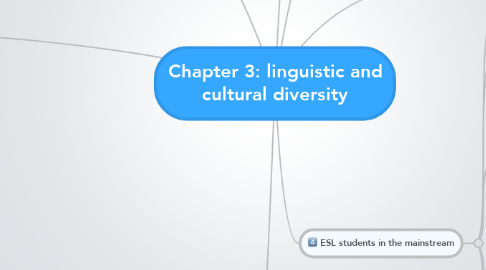
1. classroom practice
1.1. communicative language teaching
1.1.1. student centered
1.1.2. high peer to peer or peer to teacher interaction
1.1.3. focus on authentic and purposeful language
1.1.4. learning how to use the language
1.1.5. emphasis on meaning over form
1.2. aim of communicative language
1.2.1. linguistic, pragmatic, discourse, strategic competence and fluency
1.3. to help ESL students
1.3.1. provide appropriate input, use language in authentic ways, provide context, purposeful activities, task based activities, encourage elaboration, integrated approach, address grammar consciously, adjust feedback/error correction, include awareness of cultural aspects.
1.4. need for oral practice
1.4.1. need to take the pressure off
1.4.2. pair work, role plays, problem solving tasks, information gap activities, debates, jigsaw, grammar games.
1.4.3. barrier games
1.5. need for listening
1.5.1. schwa and neutral vowel sounds
1.5.2. need to know when speech is too fast.
1.5.3. meaning is constructed through...
1.5.3.1. linguistic knowledge
1.5.3.2. knowledge of the context/co text to predict
1.5.3.3. knowledge of the context of the situation
1.5.3.4. general word and background knowledge
1.6. suggestions
1.6.1. lots of practice
1.6.2. interesting to them
1.6.3. speak at normal speed but allow processing time
1.6.4. use visual aids
1.6.5. focus on meaning rather than language form
2. developing models of literacy
2.1. need to be exposed to print
2.2. reading for meaning
2.2.1. need knowledge of letters and words and syntactic conventions, and background knowledge of topic
2.2.2. grapho-phonic, syntactic, and semantic
3. assessment and reporting
3.1. need to have standards relevant to them so they don't get lost.
4. introduction
4.1. the language at home is normally the language at school
4.2. bilingualism criteria
4.2.1. it's s continuum rather than a strict cut off for who is and isn't bilingual
4.2.2. ability to communicate in two or more languages
5. where do australians come from and what languages do non-indigenous australians speak?
5.1. where do the speakers of the languages live?
5.1.1. concentrated in urban areas
5.2. only 2.4% of australians are indigenous. 25% ish were born overseas and 20% say one parent was born overseas
5.3. new arrivals are often from china and india
5.4. 21.5% of people say they speak LOTE at home
5.5. page 41 for table showing numbers
5.5.1. also shows growth. mandarin is the largest
6. student sociolinguistic profiles
6.1. asks questions like where were you born, when did you arrive, parents and their languages etc
7. ESL students in the mainstream
7.1. most teachers are monolingual english speakers
7.2. learning a new language in the language is hard
7.3. phases of ESL learning
7.3.1. fist phase
7.3.1.1. understanding and production of spoken and written english is limited.
7.3.1.2. they need survival english
7.3.2. second phase
7.3.2.1. understanding and production is progressing but still limited
7.3.2.2. often have unexpected gaps in understanding
7.3.3. third phase
7.3.3.1. generally function fluently and effectively in english but still need help
7.4. BICS and CALP
7.4.1. BICS = basic interpersonal communicatice skills
7.4.2. CALP = cognitive academic language proficiency
7.5. second language acquisition
7.5.1. children learn language as a medium of communication
7.5.2. they learn when they feel good about themselves
7.5.3. better when focused on tasks than the language itself
7.5.4. mistakes are good
7.5.5. facilitated by a comfortable classroom environment
